|
Panama Canal
Introduction
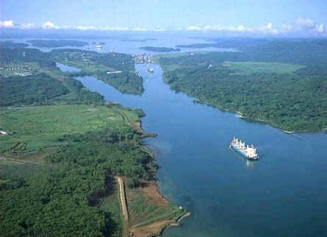 The
Panama Canal allows ships to travel the 50-mile Isthmus of Panama, between
the Pacific and Atlantic oceans, saving thousands of miles off the trip
around the tip of South America. The canal is comprised of the large
man-made Gatun Lake connected by dredged channels. Three locks are located
at each end that raise ships 54 feet to the lake level and then lower them
back down to sea level. The
Panama Canal allows ships to travel the 50-mile Isthmus of Panama, between
the Pacific and Atlantic oceans, saving thousands of miles off the trip
around the tip of South America. The canal is comprised of the large
man-made Gatun Lake connected by dredged channels. Three locks are located
at each end that raise ships 54 feet to the lake level and then lower them
back down to sea level.
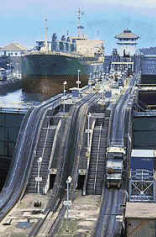 The
canal was built by the United States from 1904 to 1914 at a cost of $350
million. Under a 1903 treaty, the US controlled the waterway as well as a
five-mile buffer zone on each side of the waterway known as the Panama Canal
Zone. Panamanians resented US control. Riots ensued in the 1950s and 60s.
Twenty Panamanians were killed in 1964 and the two countries temporarily
suspended diplomatic relations. The
canal was built by the United States from 1904 to 1914 at a cost of $350
million. Under a 1903 treaty, the US controlled the waterway as well as a
five-mile buffer zone on each side of the waterway known as the Panama Canal
Zone. Panamanians resented US control. Riots ensued in the 1950s and 60s.
Twenty Panamanians were killed in 1964 and the two countries temporarily
suspended diplomatic relations.
Treaties
Two new treaties were signed in 1977 under the Carter
administration. The treaties recognize Panama’s ownership of the canal and
Canal Zone. Full control was returned to Panama at noon on December 31,
1999.
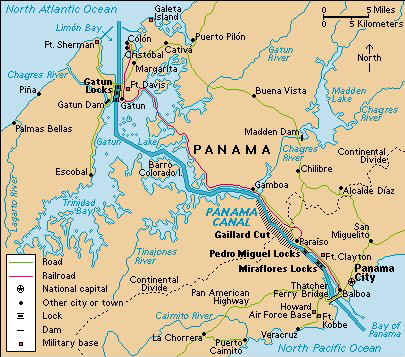
The Panama Canal Commission, a US government agency, was established in 1979
to manage the canal during the 20-year transition period. The Canal Zone was
opened to all Panamanians. A large Panamanian flag flies proudly at the top
of Ancon Hill in the former zone area and is visible throughout Panama City.
Since 1990 the canal’s administrator has been a Panamanian. The treaties
ensure that the canal will remain an international waterway and Panama and
the US will share its defense.
History
Both the Europeans and later the Americans dreamed of
building a ship canal. The Industrial Revolution brought the means to do so.
The French were the first to attempt the project under Ferdinand de Lesseps,
the engineer who oversaw the construction of the Suez Canal. Excavation
began in 1882. By 1888 the project failed due to difficult terrain, climate,
tropical disease, labor shortage and lack of funds.
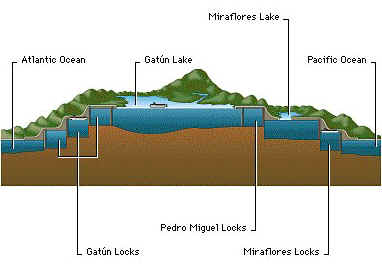 The
United States first canal project was in Nicaragua, but was short-lived. In
1902 agreement was reached between Roosevelt and the Colombian president
that gave the US a strip of land across the isthmus. Colombia’s senate
rejected the treaty. Panamanians—still a part of Colombia at that
time—feared that the US would choose a Nicaraguan route, rebelled against
Colombian rule and declared Panama independent on November 3, 1903. The US
supported the revolt, preventing Colombia from defeating the rebels. The
United States first canal project was in Nicaragua, but was short-lived. In
1902 agreement was reached between Roosevelt and the Colombian president
that gave the US a strip of land across the isthmus. Colombia’s senate
rejected the treaty. Panamanians—still a part of Colombia at that
time—feared that the US would choose a Nicaraguan route, rebelled against
Colombian rule and declared Panama independent on November 3, 1903. The US
supported the revolt, preventing Colombia from defeating the rebels.
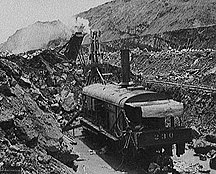 Two
weeks later Panama signed a treaty with the US giving permission for the
canal project. The treaty provided for a perpetual lease on a 10-mile wide
zone, more if needed, to build the canal, and the right to use troops. In
exchange for their independence from Colombia, Panamanians were forced to
accept the treaty, which no Panamanian ever signed. Two
weeks later Panama signed a treaty with the US giving permission for the
canal project. The treaty provided for a perpetual lease on a 10-mile wide
zone, more if needed, to build the canal, and the right to use troops. In
exchange for their independence from Colombia, Panamanians were forced to
accept the treaty, which no Panamanian ever signed.
Check out the website of the
Panama
Canal Commission. It's excellent!
|